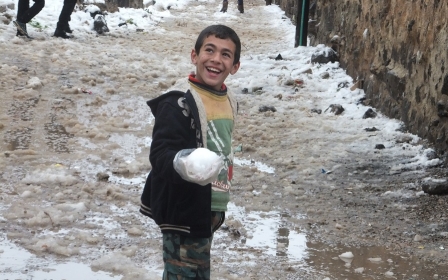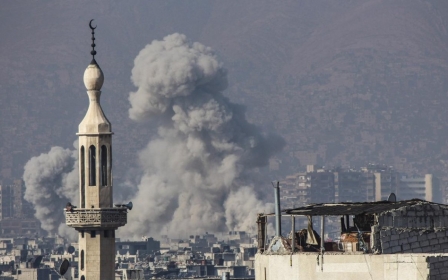Syria’s Eastern Ghouta: the latest casualty of war

Eastern Ghouta, part of the large countryside outside of Damascus, has once again become a flashpoint in the devastating almost four-year Syrian conflict.
On Sunday, military planes belonging to Syrian President Bashar al-Assad could still be heard making frequent passes up above, as the area was pounded for the fourth day in a row. Meanwhile on the streets below, fighting between rival rebel groups also continued to simmer, residents told the Middle East Eye.
The latest flare up of violence in Eastern Ghouta began on Thursday, when government raids killed 82 people and injured more than 140 others, the Syrian Observatory for Human Rights, a UK-based monitoring group, said. The attack came after a powerful Saudi-backed rebel group, Jaysh al-Islam, fired 120 rockets and mortar rounds into the Damascus’s Baramka neighbourhood, killing 10 people.
Three leading figures from two militant groups in the area - Jaysh al-Islam and Ajnad al-Sham - were also killed in fighting at around the time of the air attacks, according to reports that cited the groups’ social media pages and the government owned Syrian Arab News Agency.
'Loyalty not determined by where you are'
The fighting was some of the bloodiest seen in recent months.
“We expected the death toll to be much higher than 82,” Abu Ahmad, an activist living in the town of Kafr Batna, in Eastern Ghouta told the Middle East Eye. “There were about 50 air raids … we hadn’t experience this sort of thing since the revolution started.”
“Thursday’s strikes were concentrated in Kafr Batna, Douma, Saqba and Irbin.” The next day the strikes mainly targeted Douma, the largest town in Eastern Ghouta, Ahmad added.
The government response was all too expected. Punishment has always been swift and brutal in Eastern Ghouta, and ever since the area fell into rebel hands in 2012, the area has become one of the most-bombed regions in Syria, with civilians paying a particularly heavy price.
“Loyalty to one side or the other is not determined by where you are,” said Thaer Ajlani, a journalist based in Damascus, while commenting on the latest fighting.
“A number of those who were killed by Jaysh al-Islam on Thursday were people who made their way to the government-controlled area because they were displaced from Darayah and Douma in Eastern Ghouta by recent fighting.”
Eastern Ghouta is perhaps best known for a chemical attack that happened there in August 2012, when more than 1,000 people died due to exposure to sarin gas.
The United States laid the blame firmly at the feet of the Syrian government, and nearly followed through on its threat to oust Syrian President Bashar al-Assad by way of military airstrikes.
But things were not always so. Historically, Ghouta has been known for its fertile soil, and the area comprises an agricultural belt that hugs Damascus on its southern and eastern edges and now encompasses some 60 towns and villages, which before the revolution were home to some two million people.
According to Middle East cultural expert and author Diana Darke, its history stretches back all the way to the 4th millennium BC, with Roman ruins scattered through much of the plains.
“This is why Damascus sees it has the reason to call itself one of the oldest continuously settled centres,” Darke said. “The town of Haran al-Awamid has Roman ruins from a temple that was the centre for worshipping fertility goddesses associated with the fertility of the oasis there.”
In recent decades though, increased industrialisation and urbanisation had begun to take its toll on the once fertile land.
Centre point for anti-government protests
When the uprising broke out in 2011, Eastern Ghouta was one of the first areas to join in the anti-government protests. At first protest in Douma, dozens of protesters gathered to show their support for fellow protestors in the town of Deraa, who were the first to rise up against the government and take to the streets. The government's response was to kill 10 of the protesters in Douma, which galvanised the countryside further.
“This is why the Syrian government is still attacking Eastern Ghouta,” said Nuran al-Na’ib, a journalist with the pan-Arab al-Quds al-Arabi paper who is based in Douma. “What happened in Douma affected everyone else in the countryside. Most of those killed were civilians, between the ages of 18 and 25. Douma became a centre point for protests, with people flocking to the city from elsewhere, including Damascus.”
Abu Ahmad attributes this relatively rapid political mobilisation to the presence of two main opposition groups, the “Islamists and the Socialist Nasserites”.
“You already had a semi-political party-like organisation that was against the regime, in addition to a receptive audience,” Abu Ahmad said.
The Syrian army retaliated by enforcing a partial siege on the area in 2012. It also established a military base on Mount Qassioun in Damascus and used it to repeatedly shell Eastern Ghouta. By 2013, the blockade was tightened further as Jaysh al-Islam, led by Zahran Alloush, the son of a Salafist Saudi-based preacher, continued to grow and expand its influence.
Fertile or not, the region has been left struggling to cope and the unusually harsh recent winter weather hasn’t helped. Residents have begun complaining that getting even basic food stuffs is either extremely difficult or prohibitively expensive.
“I was genuinely surprised by how much food there was in Damascus’s centre, which is such a contrast to how people are starving in Ghouta,” said Darke, who last visited the region in December 2014 when she stayed in the government-controlled capital city.
“Central Damascus is buzzing. Ghouta is a notoriously difficult rebellious pocket for the government. You can go in and out on the official buses but no food is allowed in. Everyone there is trying to grow whatever they can.”
Abu Ahmad also complained of shortages.
“Rice and grain are accessible because the people managed to plan ahead of this winter,” he said. “But generally speaking, the situation is disastrous. Prices this winter are higher than they were last year.”
Na’ib agreed: “Most of the staple food is not available. We eat bread that is baked with animal feed instead of flour. People are dying…they are sustaining themselves by eating grass.”
Ajlani, however, dismissed talks of Eastern Ghouta being under siege, labelling it as “media propaganda”.
“The truth is that we have rice, we have sugar, we have everything,” he said. “But the problem is that there is a crazy inflation in prices on these products. One kilo of sugar in government-controlled areas costs 200 liras [$1]. The same kilo of sugar in opposition-held areas is about 3,000 liras [$16]. We are nowhere near the death-by-starvation phase, unlike other areas such as Yarmouk refugee camp.”
Stuck between a rock and a hard place
The tensions exploded in mid-November when protests broke out in Douma against Jaysh il-Islam, who were accused of monopolising food supplies and aid. The incident seems to have emboldened other smaller opposition groups who have increasingly challenged Jaysh al-Islam’s dominance, with rebel-on-rebel fighting currently on the up.
“There is violent fighting between Jaysh al-Islam and other smaller factions that control bits of land within Eastern Ghouta,” Ajlani said. “This is parallel to the Syrian army carrying out its attacks as well.”
Ajlani also warned that Jaysh al-Islam had begun clamping down on the civilian population and had stopped people from leaving Eastern Ghouta through army-controlled crossings. (The Syrian army has been keen to relocate people from the area, believing this would strengthen their hand politically.)
This has left the residents of Eastern Ghouta trapped between a rock and a hard place, facing down constant shelling by Syrian government forces on the one hand, while on the other living through the ongoing rebel struggle for control.
“People are tired from all the factions,” Na’ib said. “They don’t care so much about the protests and who is in power. Their only concern is to find food for themselves and their families.”
Abu Ahmad agreed: “Most people in Ghouta do not want Assad to stay in power, but at the same time there is a high number of complaints against the course the revolution has taken. There is no love lost for Jaysh al-Islam."
“The ethical superiority we witnessed at the beginning of the protests from the chants such as ‘Hail the Alawites’ and ‘The Syrian people are one’ has all degenerated in the face of the crimes these armed groups are committing against civilians in Damascus and elsewhere.”
New MEE newsletter: Jerusalem Dispatch
Sign up to get the latest insights and analysis on Israel-Palestine, alongside Turkey Unpacked and other MEE newsletters
Middle East Eye delivers independent and unrivalled coverage and analysis of the Middle East, North Africa and beyond. To learn more about republishing this content and the associated fees, please fill out this form. More about MEE can be found here.




